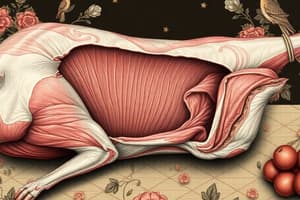Podcast
Questions and Answers
What percentage of muscle tissue is composed of fat in a beef carcass?
What percentage of muscle tissue is composed of fat in a beef carcass?
- 20%
- 10%
- 5% (correct)
- 15%
What is the main function of fat in meat?
What is the main function of fat in meat?
- Increases muscle protein coagulation
- Causes excessive shrinkage during cooking
- Enhances browning in meats
- Retains moisture during cooking (correct)
What is the primary factor related to doneness in meat?
What is the primary factor related to doneness in meat?
- Muscle protein coagulation (correct)
- Water percentage
- Carbohydrate presence
- Fat content
What is the main impact of excessive moisture loss during cooking?
What is the main impact of excessive moisture loss during cooking?
What is the purpose of barding in cooking meats?
What is the purpose of barding in cooking meats?
What is the main goal of searing meats at high heat?
What is the main goal of searing meats at high heat?
What is the effect of cooking meats from the frozen state?
What is the effect of cooking meats from the frozen state?
How is doneness indicated in dry-heat cooking?
How is doneness indicated in dry-heat cooking?
What determines the perception of juiciness in meats?
What determines the perception of juiciness in meats?
What are variety meats in cooking?
What are variety meats in cooking?
What is the recommended storage temperature for fresh meats?
What is the recommended storage temperature for fresh meats?
What is the recommended shelf life for frozen pork?
What is the recommended shelf life for frozen pork?
What is the main purpose of marinating game meats?
What is the main purpose of marinating game meats?
What is the main factor determining the perception of juiciness in meats?
What is the main factor determining the perception of juiciness in meats?
What is the effect of low temperatures in moist-heat cooking?
What is the effect of low temperatures in moist-heat cooking?
What should be done with vacuum packaged meats in storage?
What should be done with vacuum packaged meats in storage?
What plays a crucial role in binding muscle fibers together in meat?
What plays a crucial role in binding muscle fibers together in meat?
What is indicated by a shield stamp on meat?
What is indicated by a shield stamp on meat?
What are the two aging methods for meat mentioned in the text?
What are the two aging methods for meat mentioned in the text?
What are the different forms of meat mentioned in the text?
What are the different forms of meat mentioned in the text?
What is essential for identifying, boning, cutting, and carving meat cuts?
What is essential for identifying, boning, cutting, and carving meat cuts?
What specifications are important to consider when selecting meats for an operation?
What specifications are important to consider when selecting meats for an operation?
What involves important procedures such as removing silverskin and understanding when it's necessary?
What involves important procedures such as removing silverskin and understanding when it's necessary?
What is crucial for maintaining meat tenderness and moisture during cooking?
What is crucial for maintaining meat tenderness and moisture during cooking?
How are different grades of beef and veal classified by the USDA?
How are different grades of beef and veal classified by the USDA?
What are the mandatory inspections for all meat produced for public consumption?
What are the mandatory inspections for all meat produced for public consumption?
What is essential for appropriate cooking methods for different meat cuts?
What is essential for appropriate cooking methods for different meat cuts?
What plays a role in determining meat texture and grain?
What plays a role in determining meat texture and grain?
Flashcards are hidden until you start studying
Study Notes
Understanding Meat Composition and Handling
- Meat texture and grain are determined by the composition and structure of muscle fibers.
- Connective tissue, such as collagen and elastin, plays a crucial role in binding muscle fibers together in meat.
- USDA inspections are mandatory for all meat produced for public consumption to ensure wholesomeness and strict sanitary guidelines.
- Quality grading of meat is indicated by a shield stamp and is based on factors like texture, color, and marbling.
- Different grades of beef and veal are classified by the USDA based on quality criteria.
- Aging methods for meat include wet aging, where smaller cuts are enclosed in Cryovac® packaging, and dry aging, which exposes larger cuts to controlled air.
- Different forms of meat include carcasses, primal or wholesale cuts, and fabricated cuts, each serving different purposes.
- Understanding bone structure is essential for identifying, boning, cutting, and carving meat cuts.
- When selecting meats for an operation, specifications like grade, weight range, state of refrigeration, and fat limitations are important to consider.
- Fabricating meat involves important procedures, such as removing silverskin and understanding when it's necessary.
- Low-heat cooking principles are crucial for maintaining meat tenderness and moisture.
- Different meat cuts require appropriate cooking methods based on their tenderness and connective tissue breakdown, with some cuts being more suitable for braising or roasting.
Studying That Suits You
Use AI to generate personalized quizzes and flashcards to suit your learning preferences.




